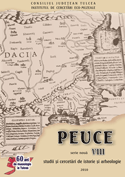Cercetările arheologice de la Isaccea – Noviodunum, punctul Cariera de lut. Campaniile 2002, 2004 şi 2005
Archaeological Investigations at Isaccea – Noviodunum, the Clay Quarry. 2002, 2004 and 2005 Campaigns
Author(s): Niculina Dinu, Laurenţiu Radu, Aurel StănicăSubject(s): Archaeology
Published by: Institutul de Cercetari Eco-Muzeale Tulcea - Institutul de Istorie si Arheologie
Keywords: Isaccea–Noviodunum; necropolis; Roman Period; 4th-5th centuries; necropola; epoca romană; sec. IV-V
Summary/Abstract: The “Cariera de lut” (Clay Quarry) in the eastern area of the archaeological site at Isaccea-Noviodunum formed in time due to the repeated mechanical excavations in the civilian settlement, in the sector between 2nd and 3rd vallums. The excavations began in the mid ’70s, and continued in the ’80s, when large quantities of land were dug out in order to build dams for allowing the natural gas pipelines to cross underneath the Danube, but there were also other types of actions that required the excavation of large quantities of land. In 2002, the area was again subject to aggressions, such as the illegal scouring of a 1,200 sqm area (40 × 30 m). Thus, as a result of the excavations, a many tombs were destroyed, but at that time their exact number and dating could not be specified. In the investigations campaigns from 2002, 2004 and 2006 at the Isaccea–Noviodunum site, 40 inhumation tombs were searched, with various alignments, belonging to a necropolis with two operational stages. Inventory – pottery, lamps, glass paste beads, bronze bracelets, iron objects – were found in five of the tombs. Some of the tombs were also affected by the household waste pits from the 11th – 13th centuries. At the Clay Quarry, a sector of the flat necropolis from Noviodunum was identified. According to the inventory found in tombs and to the stratigraphic situation, we can date it to the 4th century and beginning of the 5th century, exemplifying the transition to Christianity of a possibly autochthonous population.
Journal: Peuce (Serie Nouă) - Studii şi cercetari de istorie şi arheologie
- Issue Year: VIII/2010
- Issue No: 8
- Page Range: 203-222
- Page Count: 20
- Language: Romanian

